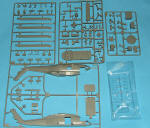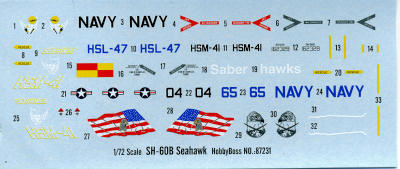
Hobby Boss 1/72 SH-60B Seahawk
| KIT #: | 87231 |
| PRICE: | $25.00 MSRP ($21.20 at GreatModels) |
| DECALS: | Four options |
| REVIEWER: | Scott Van Aken |
| NOTES: | Includes resin and photo etched parts |

| HISTORY |
The Sikorsky SH-60/MH-60 Seahawk (or Sea Hawk) is a twin turboshaft engine, multi-mission United States Navy helicopter based on the airframe of the United States Army UH-60 Black Hawk and a member of the Sikorsky S-70 family. The most significant modification is a hinged tail to reduce its footprint aboard ships.
The U.S. Navy uses the H-60 airframe under the model designations SH-60B,SH-60F, HH-60H, MH-60R, and MH-60S. Able to deploy aboard any air-capable frigate, destroyer, cruiser, fast combat support ship, amphibious assault ship, or aircraft carrier, the Seahawk can handle antisubmarine warfare (ASW), undersea warfare (USW), anti-surface warfare (ASUW), naval special warfare (NSW) insertion, search and rescue (SAR), combat search and rescue (CSAR), vertical replenishment (VERTREP), and medical evacuation (MEDEVAC). All Navy H-60s carry a rescue hoist for SAR/CSAR missions.
The SH-60B, and subject of this kit, maintains 83% commonality with the UH-60A. The main changes are corrosion protection, more powerful T700 engines, shifting the tail landing gear 13 ft forward, replacing left side door with fuselage structure, and adding two weapon pylons. Other changes included larger fuel cells, an electric blade folding system, folding horizontal stabilators for storage, and adding a 25-tube pneumatic sonobuoy launcher on left side. Shifting the tail landing gear reduced the footprint for shipboard landing.
Five YSH-60B Seahawk LAMPS III prototypes were ordered. The first flight of a YSH-60B occurred on 12 December 1979. The first production version SH-60B achieved its first flight on 11 February 1983. The SH-60B entered operational service in 1984 with first operational deployment in 1985.
The SH-60B LAMPS Mk III is deployed primarily aboard frigates, destroyers, and cruisers. The primary missions of the SH-60B are surface warfare and anti-submarine warfare.
The SH-60B carries a complex system of sensors including a towed Magnetic Anomaly Detector (MAD) and air-launched sonobuoys. Other sensors include the APS-124 search radar, ALQ-142 ESM system and optional nose-mounted forward looking infrared (FLIR) turret. It carries the Mk 46, Mk 50, or Mk 54 torpedo, AGM-114 Hellfire missile, and a single cabin-door-mounted M60D/M240 7.62 mm (0.30 in) machine gun or GAU-16 .50 in (12.7 mm) machine gun.
A standard crew for a SH-60B is one pilot, one ATO/Co-Pilot (Airborne Tactical Officer), and an enlisted aviation systems warfare operator (sensor operator). Operating squadrons are designated Helicopter Anti-submarine Light (HSL).
The SH-60J is a version of the SH-60B for the Japan Maritime Self-Defense Force. The SH-60K is a modified version of the SH-60J. The SH-60J and SH-60K are built under license by Mitsubishi in Japan.
| THE KIT |
 To my knowledge, this is the second 1/72 SH-60B to have been kitted, the other being from Hasegawa. I don't think that Italeri did one in 1/72, and while Fujimi did the UH-60 Army and Air Force variants, I don't think they did any Navy versions, but you can correct me on this if I missed it. Molding is typical of Hobby Boss in that the engraved details are nicely done, with no flash, sink areas or nasty ejector pin marks noticed. I usually find these things when I'm actually building the kit if they are there. It is obvious that several naval H-60 kits are in the works as all the bits peculiar to the SH-60B are on a single sprue.
To my knowledge, this is the second 1/72 SH-60B to have been kitted, the other being from Hasegawa. I don't think that Italeri did one in 1/72, and while Fujimi did the UH-60 Army and Air Force variants, I don't think they did any Navy versions, but you can correct me on this if I missed it. Molding is typical of Hobby Boss in that the engraved details are nicely done, with no flash, sink areas or nasty ejector pin marks noticed. I usually find these things when I'm actually building the kit if they are there. It is obvious that several naval H-60 kits are in the works as all the bits peculiar to the SH-60B are on a single sprue.
You get four grey sprues of different sizes and one clear with the various cockpit and cabin windows. The big plus for this kit is that, unlike the Hasegawa kit, there is a full sensor and station suite in the cabin area. Hobby Boss gives you a separate door that you may wish to pose open, though the instructions do not show this feature. It is difficult to tell, but apparently the collective is either not included as a separate piece or is molded in place. Two different instrument panels are provided. One is blank for a decal and the other has raised detailing. Only the one with the raised detailing is shown in the instructions as there is no decal provided.
Weapons consist of two torpedoes. These were infrequently carried as shown on the box art, so if one wants a 'normal' looking helo without them, one will have to either fill the holes for the mounting racks or build some sort of torpedo attachment points on the rack. The kit also portrays the later electronics fit with the large side RHAW sensors just under the engine exhaust. If you do not want to install these, don't open the holes in the fuselage for them.
Instructions are typical Hobby Boss with well drawn construction steps and n o interior painting information. Any modifications needed are clearly shown. Markings are for two units. First is the box art aircraft of HSL-47 with its blue CAG type tail markings. This is an overall grey (no FS number is given) with black exhaust areas. Gunze paint
o interior painting information. Any modifications needed are clearly shown. Markings are for two units. First is the box art aircraft of HSL-47 with its blue CAG type tail markings. This is an overall grey (no FS number is given) with black exhaust areas. Gunze paint references are provided for the exterior colors. The other is with HSM-41. Apparently the HSL moniker is being changed from Helicopter Antisubmarine Warfare Light (HSL) to Helicopter Maritime Strike (HSM). Regardless, HSM-41 is the west coast training squadron and has been for now over 25 years. This aircraft has a black tail section. As a note, the aircraft rarely carry any weapons so if you want to leave the torpedoes in the box, feel free to do so. The decal sheet looks to be well done and hopefully so as aftermarket for the SH-60B is minimal as best.
references are provided for the exterior colors. The other is with HSM-41. Apparently the HSL moniker is being changed from Helicopter Antisubmarine Warfare Light (HSL) to Helicopter Maritime Strike (HSM). Regardless, HSM-41 is the west coast training squadron and has been for now over 25 years. This aircraft has a black tail section. As a note, the aircraft rarely carry any weapons so if you want to leave the torpedoes in the box, feel free to do so. The decal sheet looks to be well done and hopefully so as aftermarket for the SH-60B is minimal as best.
| CONCLUSIONS |
What with the much older Hasegawa kit fetching about the same retail price as this one, and the Hobby Boss kit having a nicely done interior, this may well be your better choice.
| REFERENCES |
http://en.wikipedia.org/wiki/SH-60_Seahawk Thanks to If you would like your product reviewed fairly and fairly quickly, please contact the editor or see other details in the